“Good Night from Lamar Valley”
June 15, 2024 - 1 Comment

We don’t have good service tonight at Roosevelt Lodge so we’ll try to get our next blog posted tomorrow! Until then, enjoy this view of sunset in Lamar Valley tonight.

We don’t have good service tonight at Roosevelt Lodge so we’ll try to get our next blog posted tomorrow! Until then, enjoy this view of sunset in Lamar Valley tonight.
The day started at 6:25 AM at Mammoth Dining for breakfast. After breakfast, we took the road less traveled to take a look at the backside of Mammoth Springs. Mammoth Springs, one of Yellowstone’s geothermal vents, is comprised of many smaller springs that produce steam, amongst them Narrow Gage, Canary Falls, Prospect Terrace, and Mound Springs. Yellowstone has the largest collection of geothermal features in the world as a result of underground volcanic activity.

After a 2.5 mile hike around Mammoth Springs, we headed down to meet two park rangers and hear their stories from the past 30 years in the park. Ivan Kowaski works in backcountry permitting and training for visiting park goers. Bob Fuhrmann is director of Education at the park and works with the Youth Conversation Corps.
During a short break, we had a chance to see the visitor center, a family of Great Horned Owls in the tree outside the visitor center, and had wraps for lunch. After lunch, we were joined Ranger Michael who works with teachers, students, and citizen scientists in the park. He led us on a hike to spot pikas for a citizen science project called Pikas in Peril. While spotting a pika, we also spotted a very cheeky golden-mantled ground squirrel.
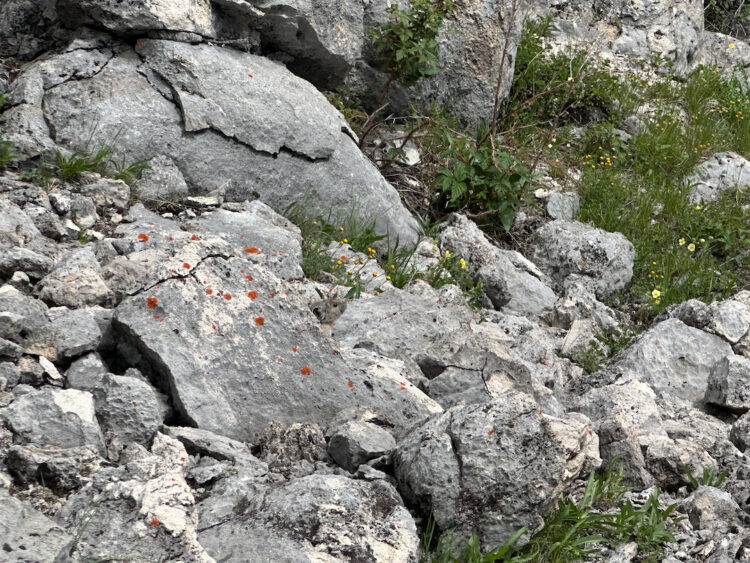
After dinner at Cowboy’s Lodge and Grill in Gardiner, Montana (just North of the park), we set off for an evening nature drive. Evening animal sightings on our drive included: elk, Ruddy Duck, our first bison, our first black bear, a cinnamon colored black bear, two bachelor mule deer, a coyote, Sandhill Cranes, pronghorn, and most notably gray wolves from the Rescue Creek Pack.
We ended day 2 with a group meeting by a herd of bison with many calfs and took the opportunity to discuss our first impressions of Yellowstone and our favorite moments so far.
We are so grateful for our first full day at Yellowstone to have been jam packed with so much awe and new knowledge!
Laura Martinez, Jessica Pichan, and Dave Williamson
We started bright and early in Raleigh and ended up (still bright) but later in Yellowstone National Park! We checked into our cabins, hiked to a scenic cliff where we revisited our goals and set our new ones for the trip.

We bonded over our excitement to leave behind a school year, the demands of being needed and responsible for so much, and our desire to live in the moment, be present and take it all in as we begin this journey together!

To top it off…. We saw lots of elk in the sagebrush, playing in the road, and grazing the lawns in Mammoth, where we are staying tonight.
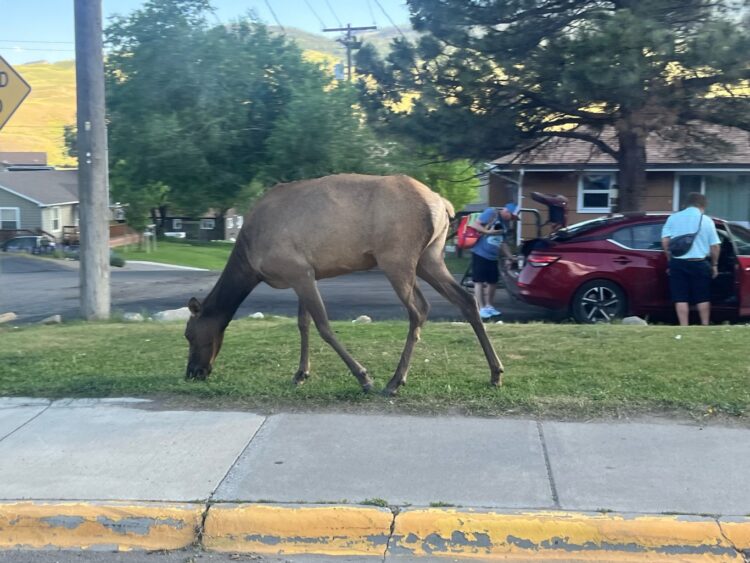
As the school year winds down, our group of 12 intrepid educators is getting ready for an educational adventure: our 2024 Yellowstone Institute. Early on June 13, we will board our first flight towards Bozeman, Montana, arriving in the park later that day. We’ll spend ten days taking a deep dive into Yellowstone’s ecology, geology, and history as we rise early to watch wildlife, explore some of the park’s many trails, and learn from experts and each other.
At the Museum, our staff leads have been finalizing the schedule, packing binoculars and spotting scopes, printing stickies for everyone’s journals (including maps, our itinerary, and daily team assignments), and cramming just a little bit more Yellowstone knowledge into our brains.
Some of our participating educators have shared how they’re preparing, too…
From Jessica Pichan: “Once May comes, things get a bit hectic at school with the EOGs quickly approaching, so it has been nice to have our Yellowstone trip as a light at the end of this tunnel! I am getting ready for Yellowstone by making sure that my family goes hiking each weekend. Last weekend our hike was one that created core memories because it involved a quest to find cicadas. I am going to make sure that I start walking on the treadmill at the gym with increased elevation again during the week… I started out the year strong in preparation, but have fallen off a bit.
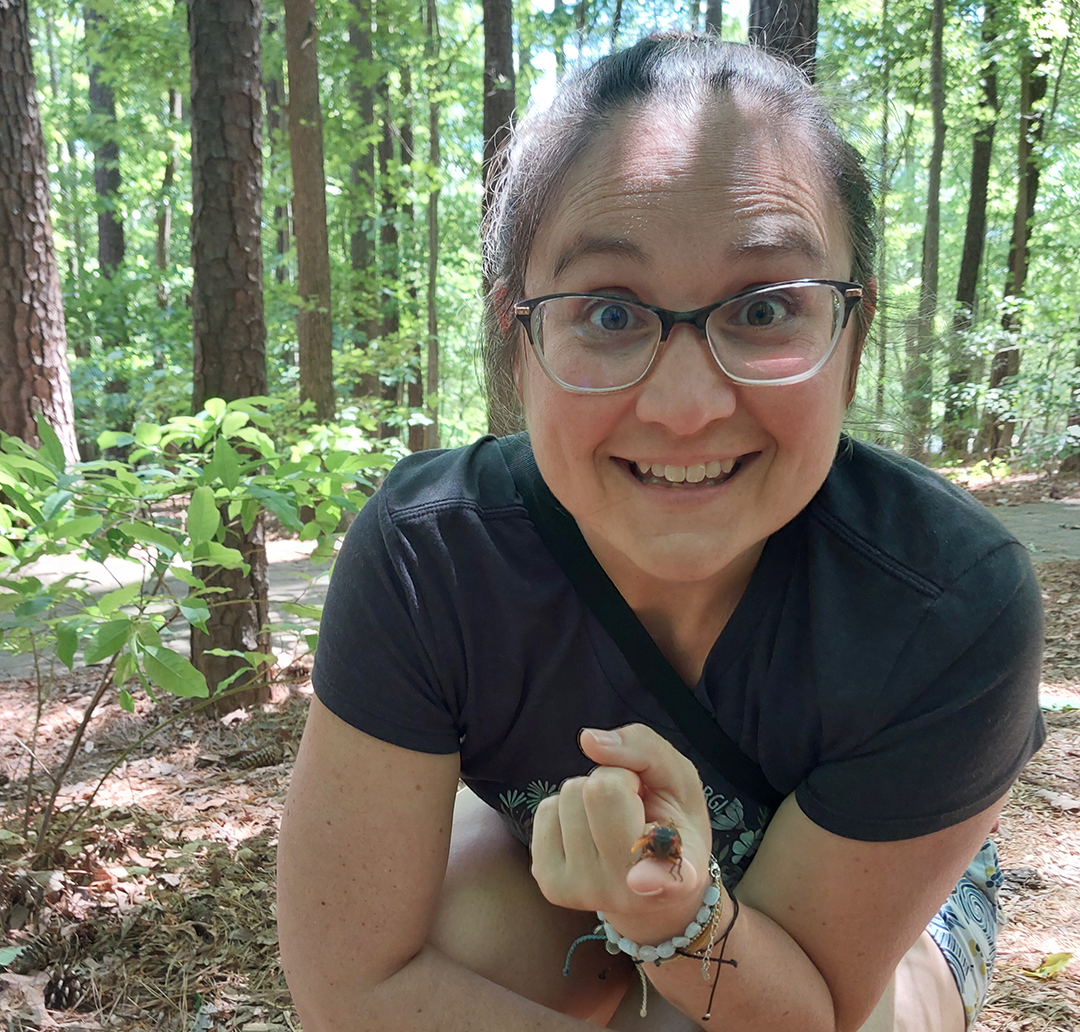
Jessica Pichan with a periodical cicada
“Yellowstone has been on my bucket list for a long time and I cannot wait to soak in the views and to learn things that I would not if I were to go with my family alone. Our youngest daughter (5) has Type 1 Diabetes, so I worry about something happening while I am so far away, but I know that she will be safe and in the most capable hands with my husband. I realize that I cannot pour from an empty cup and I know that this adventure will recharge me in ways that I cannot even begin to put into words. I am so incredibly grateful to have been chosen to be a member of this Yellowstone cohort!”

Laura Walkup has already started packing: “I’m getting ready for Yellowstone, so I’m taking stock of my toiletries by making a list and checking it twice! I’ve also gathered my journal, art supplies and writing materials. So excited to see new sites with my new friends!”
Allyson McFalls shared how she’s combining Yellowstone prep with a field trip for her students!
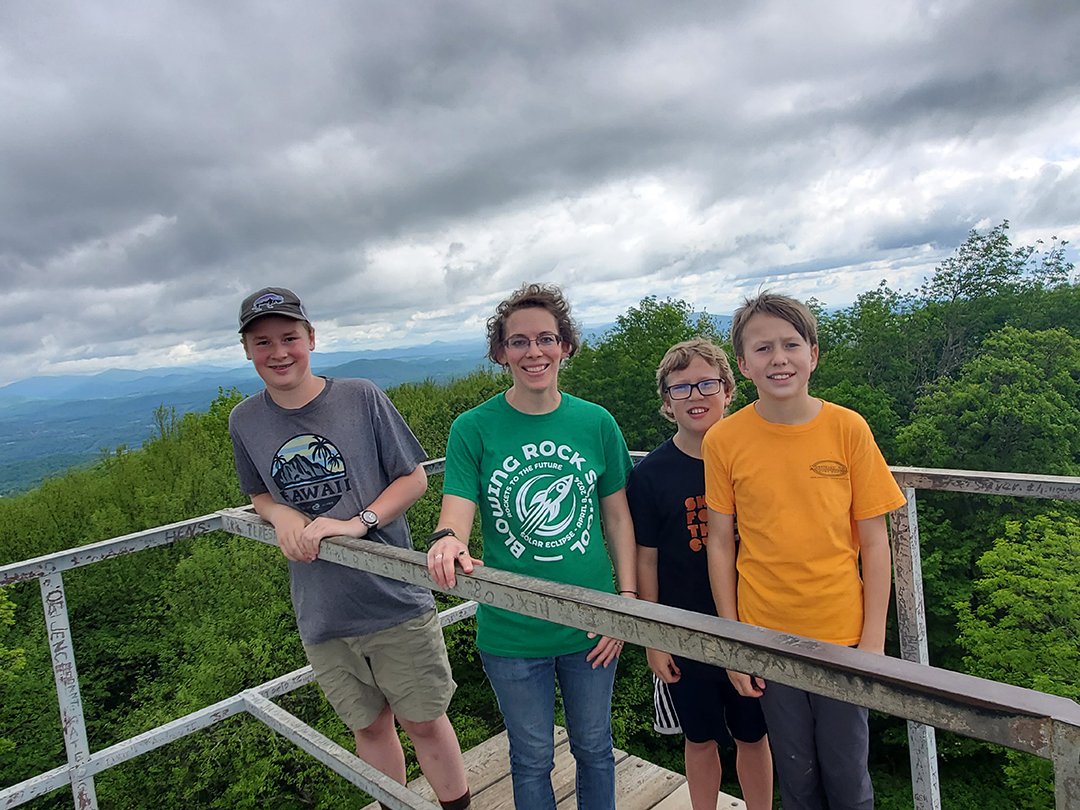
Allyson and students on a fire tower
From Allyson: “As part of my Yellowstone training, as well as an effort to get our students out of the school while other grades were testing, my teammate and I took our sixth grade class hiking at Moses Cone along the Blue Ridge Parkway. The weather looked dicey all week (at one point forecasts were calling for hail and high winds!), but thankfully the morning of our hike, things were just overcast. We completed the 5 mile hike with 30+ students in under two hours, including climbing to the top of the fire tower for some incredible views of the Blue Ridge Mountains. My hiking boots seem well broken in, and over 20,000 steps later, I’m sure that all the kids slept well that night. I’m looking forward to the new terrain and challenge of the Yellowstone trails, as well as all the new plant and animal species we’ll see along the way.”
We hope you’ll follow our adventures as we post blogs on our Yellowstone Institute from June 13-22. Send questions our way by leaving comments on our posts, and we’ll do our best to get back to you!
How does one describe the indescribable? Language does not possess the capacity to capture the totality of the past ten days and all that we experienced. In an attempt to express how we have been impacted, some words that have emerged over the course of our time here include awesome (in the true sense of the word), renewal, humbling, surreal, grateful, overwhelming, inspired, connection, relationships, and sublime, to name a few. Such words only begin to reveal the deep meaning found in such a short time and the experience that is indelibly imprinted upon each of us. We are — as people and as educators — forever changed in ways both known and unknown. While we are all changed in different ways, it has been the combination of the people we have met and learned from, the vast and diverse landscape, and the abundant and varied wildlife and lifeforms we have experienced that have produced a life-altering effect.
Furthermore, it is not coincidental we have been so profoundly impacted; it is thanks to our thoughtful, knowledgeable and dedicated leaders, Melissa, Greg and Martha, all of whom have not only given their time but have truly given all of themselves. Their passion, insight, patience and flexibility have been unwavering and instrumental in making this trip like nothing else, especially Melissa who, even after forty visits, exudes awe, wonder and joy for the wild majesty that is Yellowstone. From all of us, thank you!

Our trip leaders — Martha, Greg, and Melissa.
Yellowstone contains worlds within worlds, rich with life and history on a scale that is immeasurable. First arriving in the park after an especially early flight, we emerged from a sleepless haze and were quickly introduced to the impressive mountain landscape, winding rivers, and fascinating wildlife: bison, pronghorn antelope and elk. The excitement was palpable. The massive Roosevelt Arch stood as a gateway to the unknown as well as a reminder of the long and complicated history of the land. Our first five days in the Lamar Valley and surrounding area was a foray into our first world within the park. This vast landscape of rugged, looming mountain peaks with steep and stark cliff faces covered in dense groves of Douglas fir trees, sloping into expansive valleys blanketed in lush grasses patchworked with sagebrush and rushing rivers, is truly a sight to behold. Dense layers of clouds could not fully hold back the rays of sun creating a kaleidoscope that shimmered down to the Earth and cast shadows that undulated like waves across the sea.
Each day in the Lamar Valley was full of wildlife and wonder. Despite the cold and wet, a sense of curiosity and inspiration quickly spread throughout our group as new friendships bolstered the shared excitement. Our first full day we were greeted by a moose near our rustic accommodations and shortly thereafter a mother grizzly bear with two playful cubs on a hillside near the road — a truly special and memorable experience that already made us question, how could things get much better? This question was a recurring theme each day, yet somehow each day managed to unveil new depth and beauty. Over the following days, we tracked wolves and witnessed a pack attempt to get a baby bison (but mama bison was not having it, and fought off seven wolves, and baby was quickly surrounded in the safety of the herd); a mother grizzly bear nursing her cubs; baby foxes playing on logs; baby pronghorn antelope with their mother; elk lying in the school football field; and countless birds, wildflowers and breathtaking vistas. The frequency and quality of sightings and unique animal behavior observed was truly astounding and elicited a joy and levity that even unseasonable weather and functioning on minimal sleep couldn’t detract from.
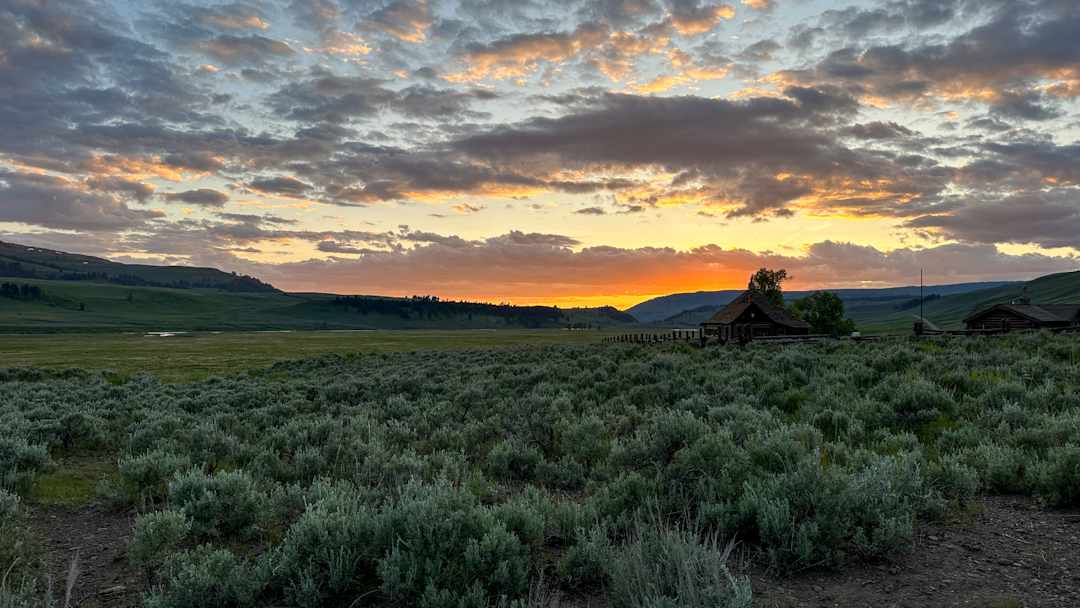
Sunset in Lamar Valley.

Hiking in the northern range.
While the daily exhilaration of the natural beauty was otherworldly, another aspect that made the experience even more special was the amazing experts we met and who took time to help us learn about what we were seeing on even deeper levels. Ranger Michael, Kira, Dan, Rick, Pat and others were such an integral part of making our experience even more special and rich, and each added something that could not be quantified or even described because they did not merely share information, they shared their passion, their insatiable curiosity, and a new lens to look at the park and at life itself through. Even more, they showed us ways we can learn from their lives to enrich our students’ learning and show them new possibilities for their future, and the positive impact they can have in myriad ways. The gift of each of these experts is truly a blessing, the impact of which will help grow the next generation of researchers, conservationists, ecologists, geologists, naturalists, biologists and so much more.
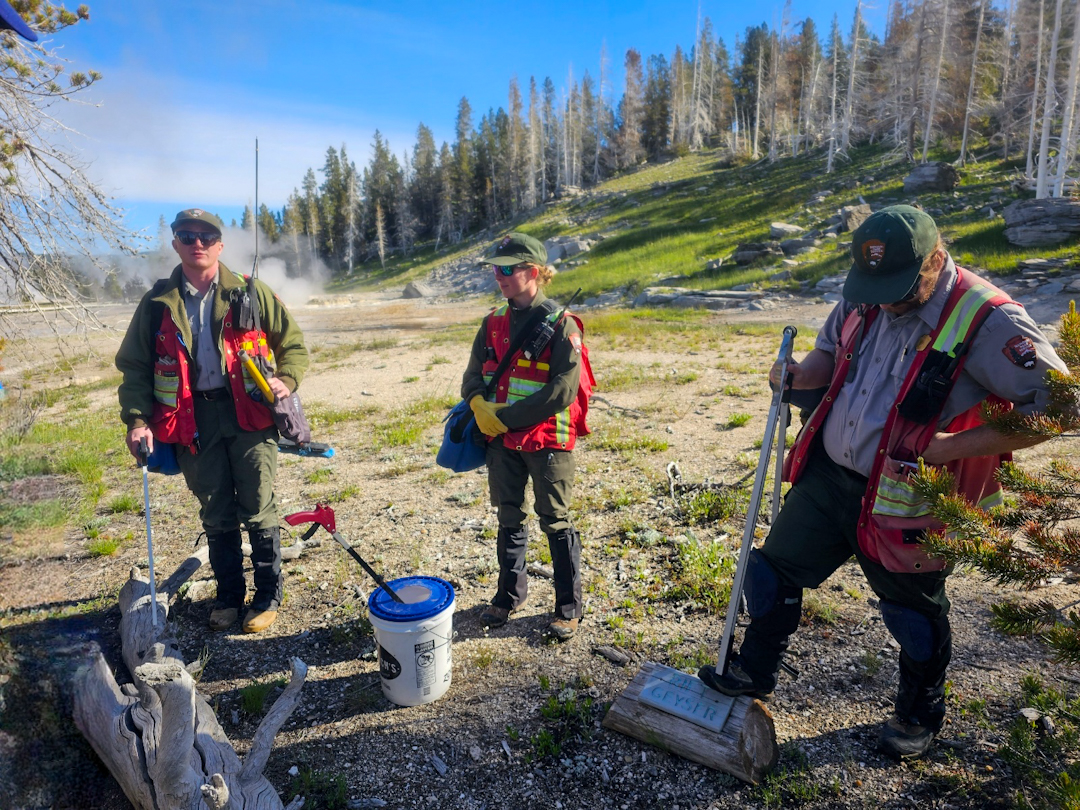
An impromptu meeting with the park’s geology crew in Upper Geyser Basin.
After days immersed in the awesomeness of the northern range, we entered a new world in the park as we headed down to the outer rim of the caldera, through the canyon and into the Yellowstone volcano’s caldera. In the Yellowstone River canyon, rushing river rapids carved through volcanic and hydrothermally altered rocks, exposing among the cliff faces of the canyon a historical account of our planet going back millions of years. The story told is one of dynamic change, volatility and the power of nature that has not only shaped the landscape, but also the subsequent life that has existed, from the tiniest microbes in the most extreme environments to the ways people live on and use the land.
Heading into the caldera, geothermal features unfold across the land, making the Upper and Lower Geyser Basins truly otherworldly. Seeing features such as the Dragon’s Mouth made clear how indigenous peoples didn’t just see rocks and water, but the source of creation itself and built their sense of existence and their culture in relationship with the Earth. The Earth is not a resource to consume, it is sacred and to be revered, honored and respected — a lesson we all would benefit to learn.
From the caldera, we drove out of Yellowstone to experience the majesty of Grand Teton National Park, just miles away. While close in proximity, the Tetons stand as a world all their own. Walking into the Jackson Lake Lodge, tired and desperate for coffee, our bodily concerns immediately faded from thought, and time and space stood still as the mountains enraptured us. Later, a walk to Taggart Lake provided a truly breathtaking view and moment of transcendence and peace. It was in countless moments like these that we felt a unity and connectedness with all of life, an experience of the sublime. After a brief day trip in the Grand Tetons we made our way back up to the geyser basin and Old Faithful, then on to the North Entrance to finish out our time in Yellowstone, a time and place like no other.
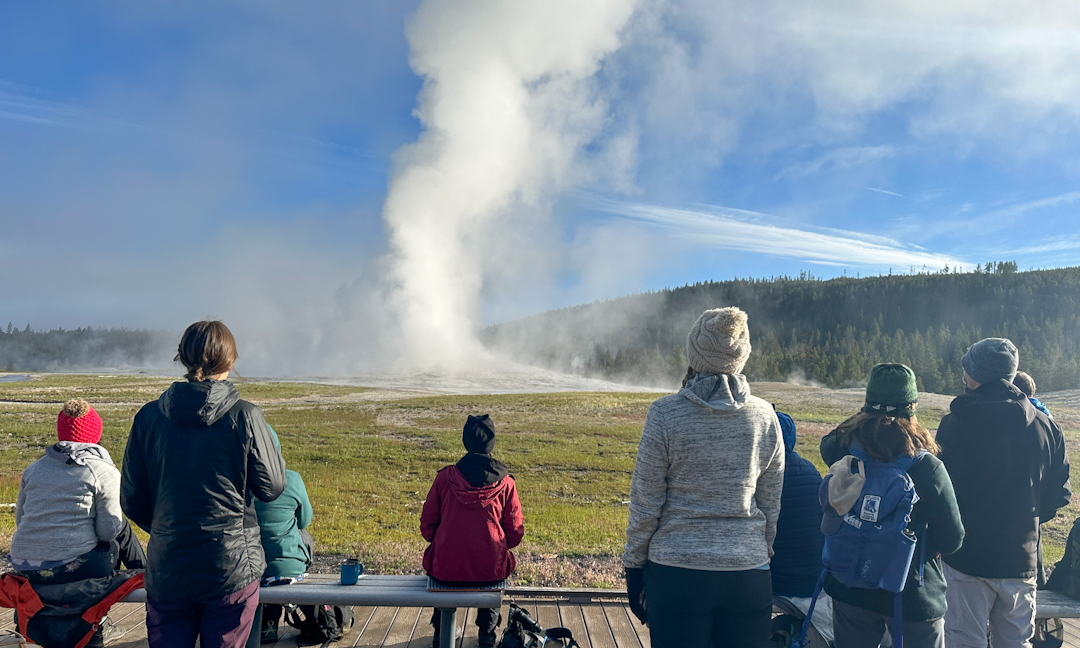
Watching Old Faithful at dawn.

Sawmill Geyser in eruption.
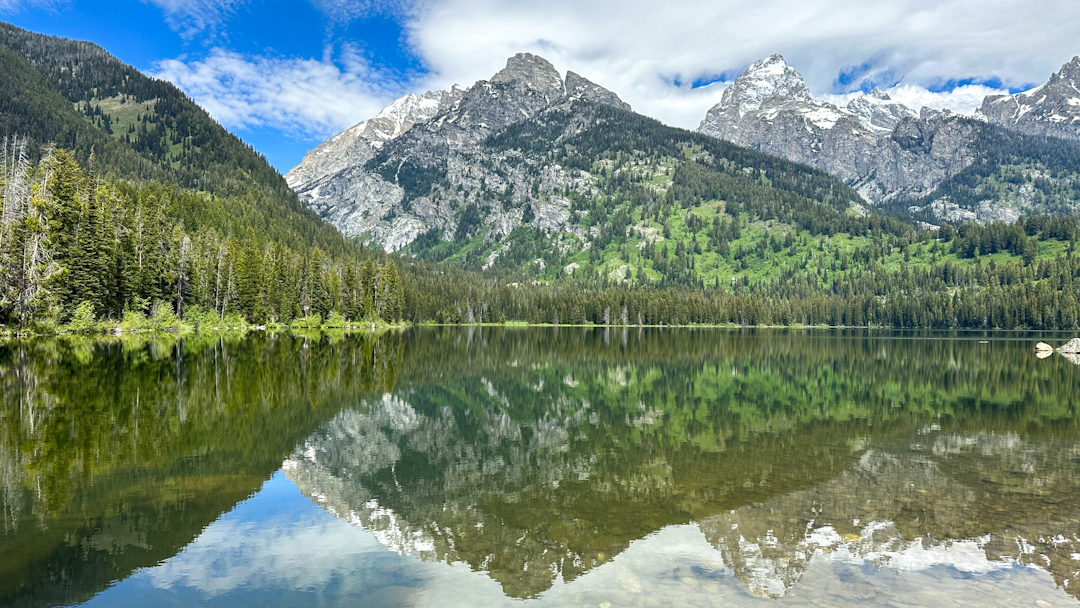
View of the Tetons from Taggart Lake.
There is the Greek maxim, “know thyself,” and Yellowstone is a place that instills in one a new and deeper understanding that is born out of experiencing the interconnectedness that we all share, for knowledge is relational. Amidst the landscape, the relationship between one individual and the hills, the rocks, the wildlife, the sky and so much more are all-consuming. Each sensation is not only stronger, it speaks of who we are and what it means to be human in the most humbling way. It opens you to the simultaneity of our insignificance and our significance, and contained in this paradox you find yourself in a truer sense than had previously been known. So, back to the question posed at the beginning of this post: How does one describe the indescribable? One doesn’t; it can only be experienced.
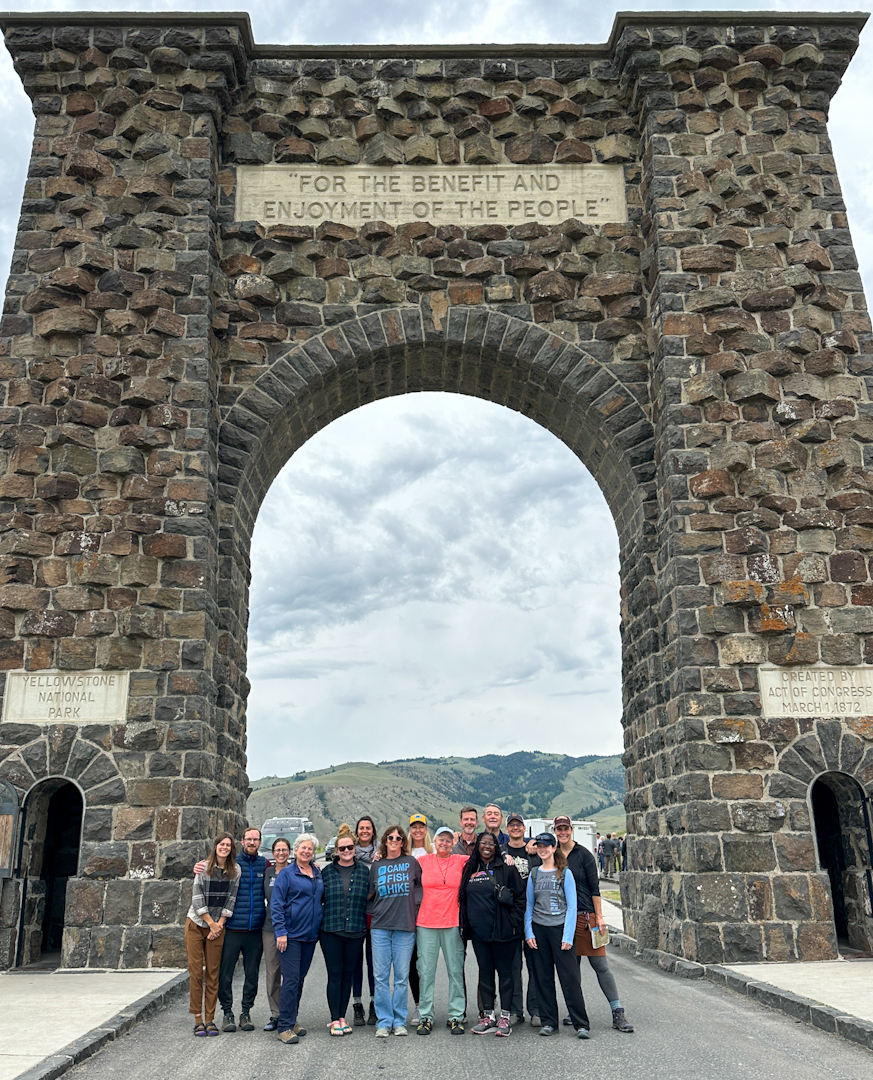
We finished our trip where we started — at the Roosevelt Arch — the same people but changed for the better by our experience in Yellowstone.
Shortly after sunrise, the group enjoyed a mostly private viewing of Old Faithful erupting at precisely 7:17 a.m. The geyser is famous for erupting at a (mostly) regular interval and its high sprays do not disappoint. Afterwards, we enjoyed a hike in the Upper Geyser Basin, seeing several other thermal features including surprise eruptions from Spasmodic and Sawmill Geysers. We had a rare opportunity to talk with one of the park’s geology crews that was out in the basin collecting data from meters at the features. They talked with us about the research they are doing using the data, and how they are responsible for collecting items that fall away from the safety of the boardwalk.
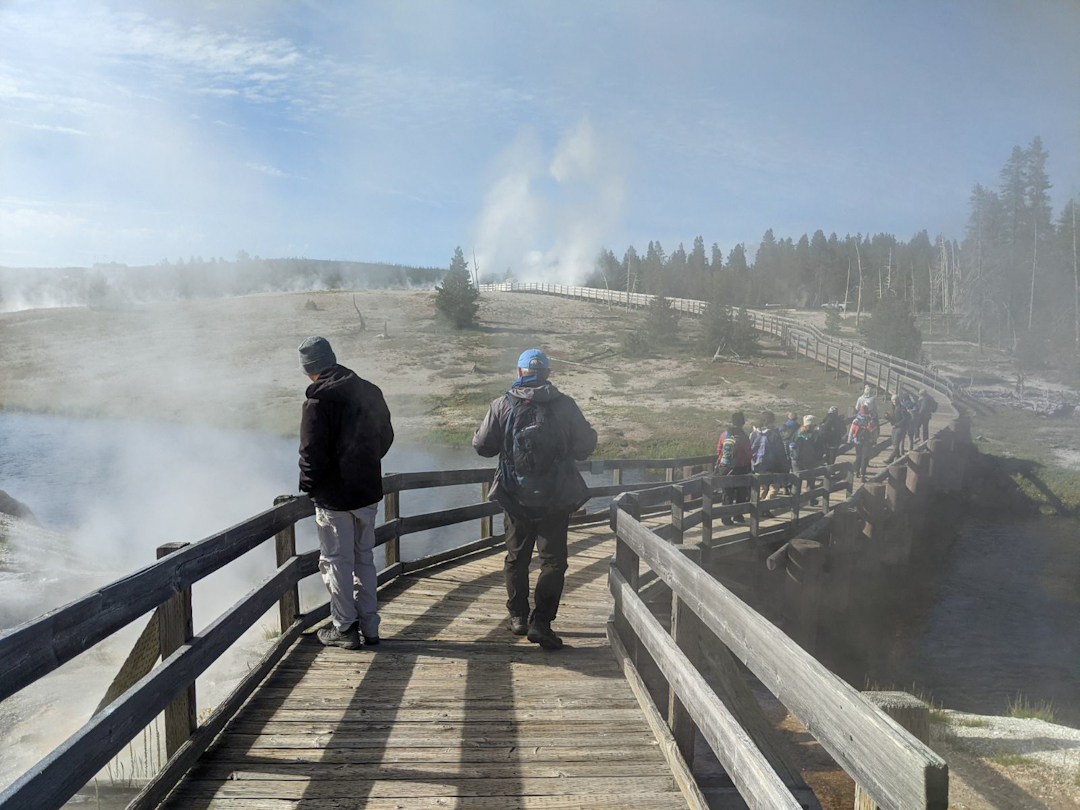
Hiking through Upper Geyser Basin
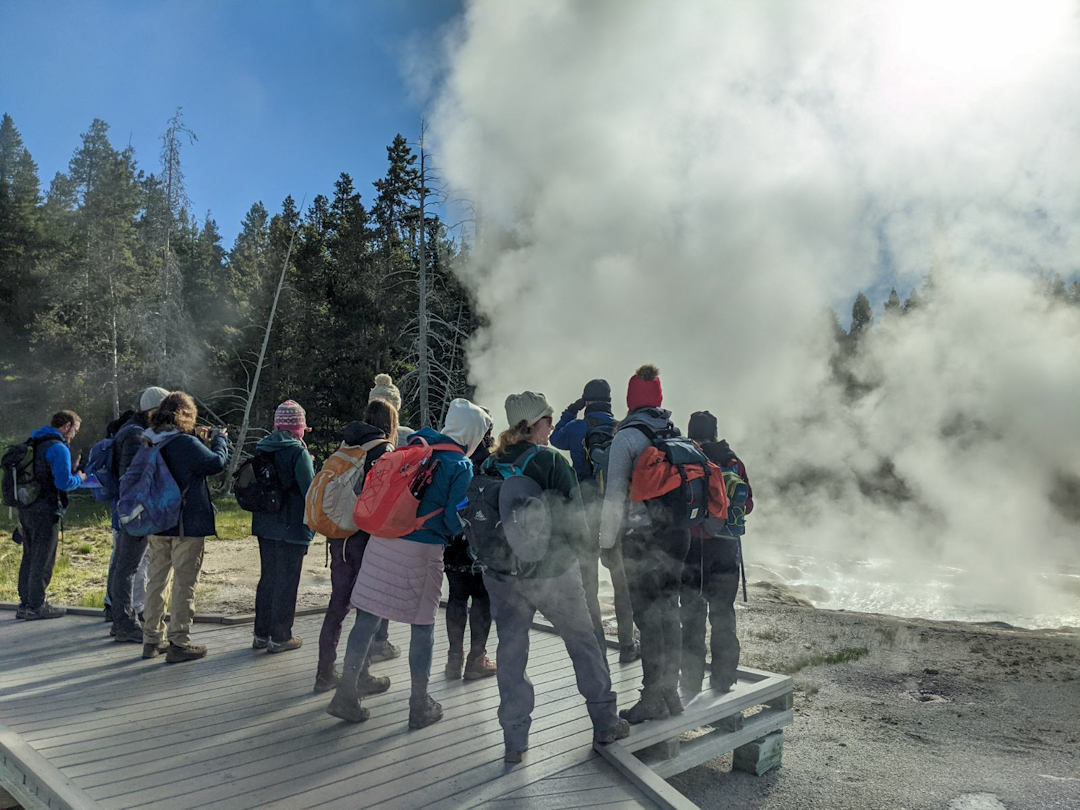
Watching Spasmodic Geyser
The basin’s landscape could be likened to a moonscape — white geyserite covers the ground and little plant life. Trees that surround the features are bleached white over time by geyser spray and by soaking in mineral-rich water through their roots. Don’t let these features fool you! They are filled with microorganisms called thermophiles that thrive in the heat. Soon afterwards, Andy taught us about the bioprospecting of these creatures and how they have been used in scientific research since the 60s. This research unlocked the door to DNA sequencing, the Human Genome Project, medical advances, and other practical applications.
The morning was rounded out with a visit to the visitor center and the Tribal Heritage Center. The Tribal Heritage Center showcases the arts and crafts of indigenous tribes whose culture and history are tightly interwoven with the park. Today’s artist-in-residence, a Shoshone and Arapaho woman, shared her intricate beadwork with visitors. She explained how the patterns and colors in the beadwork have meaning to the garment’s wearer. One more viewing of Old Faithful and ice cream and then we were off!
We stopped at Fountain Paint Pots for a brief walk to see various thermal features including Celestine Springs, Leather Pool and Red Spouter. What makes this spot special is the proximity of the different types of thermal features to one another. We also spotted a coyote carcass near a geyser, reminding us just how volatile these features are. After lunch, we explored Obsidian Cliff and learned about how Native American tribes used the precious resource from Becqui. In addition, Scott schooled us on how invasive species are impacting native species in the park. The day was finished with our arrival in Gardiner for the night and a final group meeting. During the meeting, tears were shed, goals were revisited, regrets were let go, and connections were deepened as we shared the immense impact the trip has had on each of us. Conversation continued over dinner as we prepared to leave this transformative experience with hearts full of gratitude and joy.
The team turned the vans southward today, headed for the Tetons. Early morning coffee at the Jackson Lodge invigorated the crew and everybody was ready to take in the beauty of these picturesque mountains. At the Willow Flats overlook, we took scenic photos and Greg and Melissa shared with us some of the human and geologic history of the greater Tetons region. Melissa also had her “Sound of Music” moment among the beautiful wildflowers of the Jackson Hole valley.
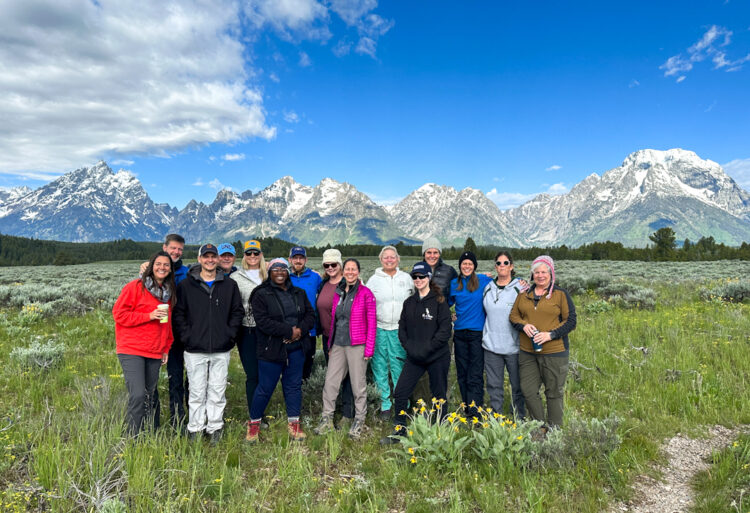
Group with the Grand Tetons
Next, we braved the crowds at Taggart Lake for a “perfect weather hike” – a 4-mile loop to the lake and back. Many pictures were taken lakeside as South, Middle and Grand Teton peaks provided the perfect backdrop. Those that bird (and they know who they are) enjoyed a plethora of birdcalls (Hello, Green-tailed Towhee!) and special sightings such as two darting MacGillivray’s warblers. The weather was almost warm, and we enjoyed shedding heavy coats and thermals. Swallowtail butterflies flitted and tent caterpillars wiggled in the midst of the vegetation. The aspen-lined trail followed the hillside down along babbling brooks, finally emerging into a sage-covered valley.
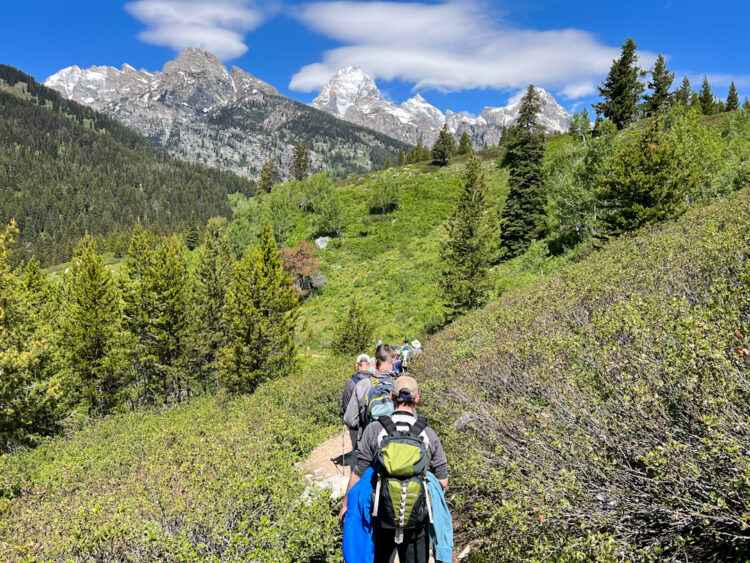
Group hiking the trail to Taggert Lake
After a picnic lunch, our next stop was the Laurance S. Rockefeller preserve. The visitor center provided the group a moment of quiet reflection. Some chose to sit outside in nature reflecting and journaling. Others took a brisk 3-mile loop hike to Phelps Lake; another exquisitely mountain-framed loch. Laurance S. Rockefeller believed in the power of nature to restore and sustain the human spirit. He envisioned a place where visitors could experience a spiritual and emotional connection to the extraordinary natural beauty of Phelps Lake and the Teton range. This vision was enhanced by sensory rooms inside the center where we experienced the sounds and sights of the Grand Teton National Park. A quote from a poem by Terry Tempest Williams on the wall outside the soundscape room states, “Nature quiets the mind by engaging with an intelligence larger than our own.”
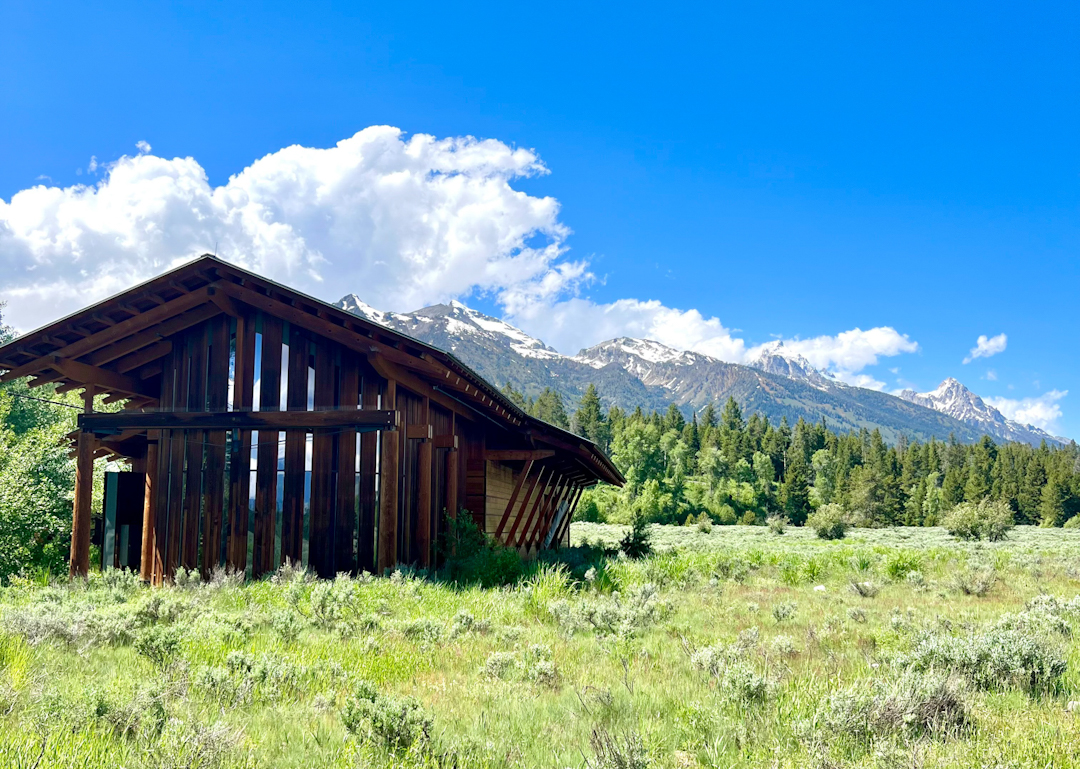
Visitor Center at the Laurance S. Rockefeller Preserve
On the way back north, we stopped for some excellent pizza at Leek’s Marina on Jackson Lake. As the sun was setting, we had our penultimate group meeting on the shore of Lewis Lake. Martha gave us the challenging task to describe our Yellowstone experience in three words. While no single word could do this journey justice, some of the words mentioned were reflective, grateful, invigorating, humbling, restorative, flora and fauna, and splendor. Another quote from Terry Tempest Williams’ poem in the Rockefeller preserve summarizes our experience well: “We see the Great Peaks, mirrored in water—stillness, wholeness, renewal. Reflection leads to us restoration.”
We all emerged from our little yellow cabins to eat breakfast together and head out to hike Pelican Creek Nature Trail on Yellowstone Lake. Our daily physical/weather team today took a temperature reading of 38 degrees! We were bundled up and ready to keep exploring. Some of us journaled, some sketched the scene out in front of us, and others enjoyed the view while letting their minds wander.
Excerpt from Talicia’s Journal Entry:
“I’m losing track of the time. All the days are packed with new adventures, new discoveries, and new knowledge. I sit at the edge of Yellowstone Lake observing the view. The mountain caps are covered with snow. Pelicans perch on the island not far from view. Are they taking it all in too? I close my eyes and feel the breeze blowing gently across my face. I listen to the water swoosh, swoosh, swoosh- waves bouncing back and forth in a rhythmic dance. I’m without words to adequately describe its beauty, so I take it all in. The cool sand beneath me, sediments of earth’s history- shades of mocha, cocoa, and cream, a beautiful mix around me…”
Next, we headed to meet National Park Service fisheries biologist Pat Bigelow at the marina. She told us more about the NPS’s conservation efforts to reduce the Lake Trout population that unfortunately made its way to the Greater Yellowstone Ecosystem after being introduced here by humans. These fish outcompete the native Yellowstone cutthroat trout and disrupt the delicate food web, causing a variety of negative effects to many other species. Forty-two species of Yellowstone predators (including grizzly bears and white pelicans) prey on cutthroat trout because of the shallower waters they inhabit. Lake trout, which typically stay in deeper waters, escape this predation thereby further exacerbating the pressures on cutthroat trout.
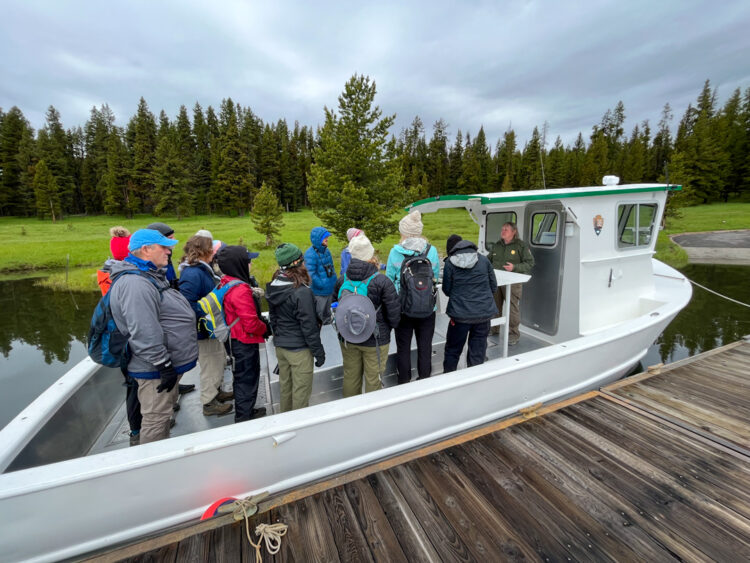
Learning about the gill nets NPS uses to remove lake trout from Yellowstone Lake
A few more stops along the way to our next destination included lunch at Angler’s Bluff, the Continental Divide at Isa Lake, and Kepler Cascades.
After cold and wet conditions all morning, it was delightful to make our way through amazing geothermal features of the park in the Upper Geyser Basin. We stopped at Black Sand Pool, otherwise known as Thumper. The sun above us and the earth beneath us warmed both our bodies and spirits as we laid on the ground and felt the “thumps” or vibrations of the pressurized water and steam escaping from below.
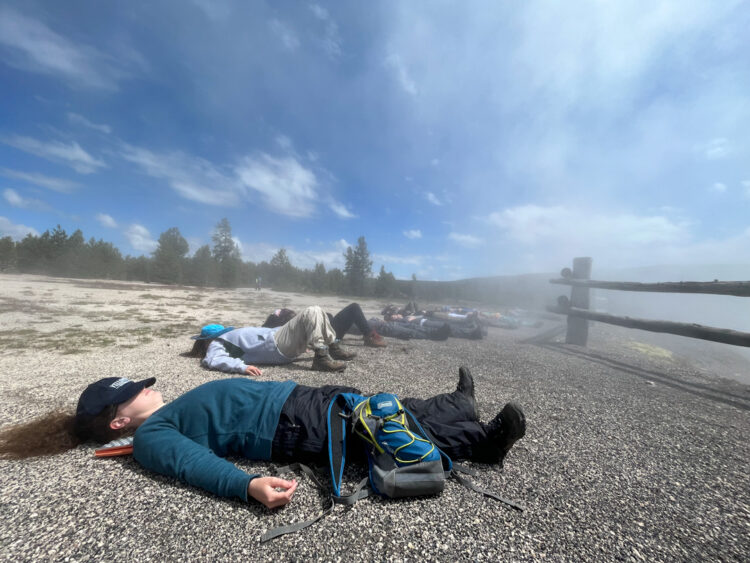
The group laid down on the ground near Black Sand Pool to feel it thump.
We also saw a number of geyser eruptions including Daisy, Beehive, and OId Faithful. Did you know that Yellowstone National Park is home to more than half of all the world’s geysers? It is no wonder that people travel far and wide to see these unique and powerful displays of nature!
After a quick dinner, we headed to Grand Prismatic Overlook for an evening hike. The thermophiles (heat loving microorganisms) living in the pool give this water the beautiful rainbow-like colors for which is it famous.

Sunset at Grand Prismatic Spring
It was the perfect place to have our end of day group meeting where we discussed highlights of the day and personal obstacles and triumphs we have experienced so far on this trip. We are heading to bed at the Old Faithful Inn, ready for another great day tomorrow.
Good evening from Yellowstone! We are writing tonight from the magnificent Yellowstone Lake Hotel after spending five cozy nights at the Grizzly Lodge in Silver Gate. We started our migration south bright and early and headed into Lamar Valley one last time where we saw several mountain goats on the side of the road. After several stops along the way for wildlife viewing, we came upon a wolf jam — a traffic jam composed of people watching wolves. We set up our spotting scopes on a hill and quickly spotted a lone, collared wolf in the sage, who turned out to have quite a story. Also watching on the hill was Rick McIntyre, renowned wolf interpreter, author, and storyteller. We were super fortunate that he was willing to take a break in the wolf spotting to entertain us with the story of that wolf in the sage, named Wolf 907, and some of the Yellowstone wolfpacks. His passion and moving stories made the wolves so relatable to the human experience. We know these stories help us make connections to these beautiful animals as we see ourselves in them. This is another example of the beautiful generosity of all the people we have met here at the park, from experts to fellow visitors.
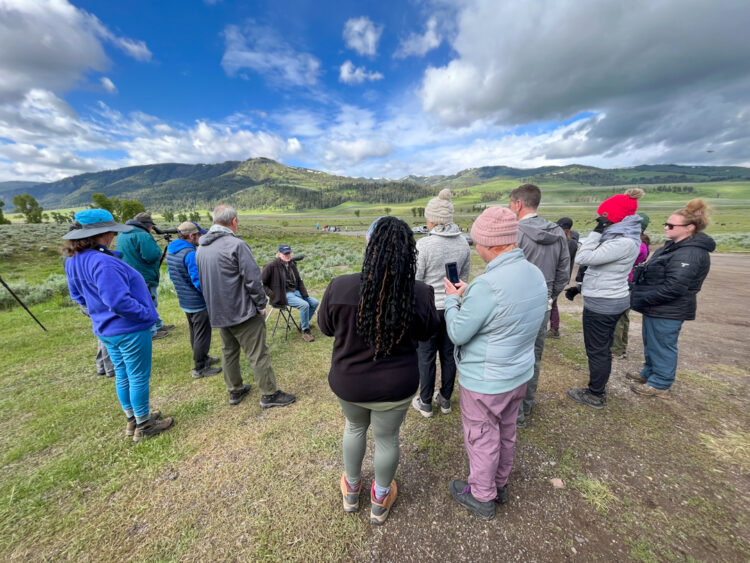
LIstening intently to Rick’s stories in Lamar Valley
The afternoon yielded a 4-mile loop hike along the south rim of the Grand Canyon of the Yellowstone. We entered what could only be described as three different worlds. First, we saw the amazing Canyon with breathtaking views, and learned about the landscape that inspired painter Thomas Moran. As we turned the corner on the trail the landscape transformed completely. Steaming mud pots reeking of sulphur fumes could be seen around us, and we were fascinated at the changing landscape and high ground temperatures caused by these features. We descended a little further down the path to a serene lake, Clear Lake, where the lodgepole pines were mirrored in the turquoise blue water. The view captivated us, and we stopped for a moment to reflect and spend some time journaling. Our hike ended with a trek along a muddy path studded with wildflowers, and we loaded into the vans for our next adventure!
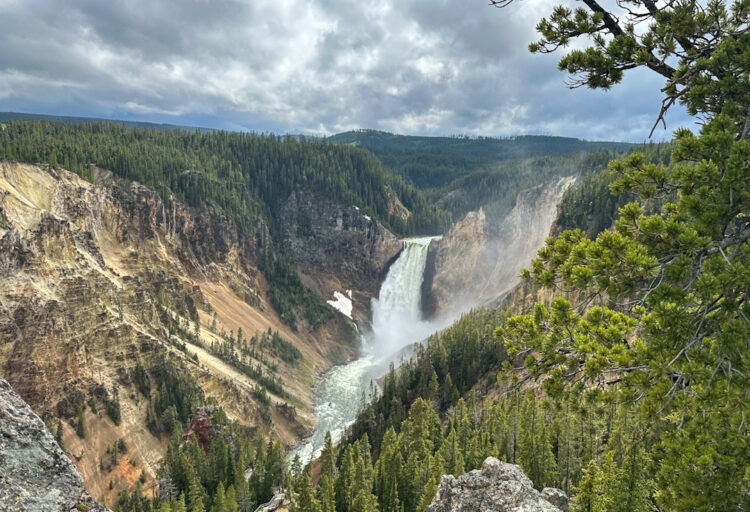
Lower Falls of the Yellowstone
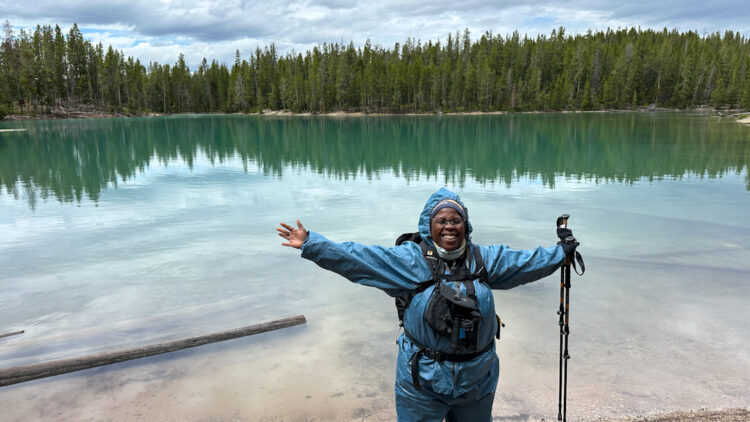
Talicia in front of beautiful Clear Lake
The thermal features of the park are stunning to behold! We joined throngs of visitors walking boardwalks alongside bubbling, gurgling, steaming, stinking pits of water and mud. There were fanciful names for some of the features, including Dragon’s Mouth Spring, which looked like the entrance to the underworld. It is actually steam and other gases exploding through the surface water, causing it to crash against the walls of the cavern. One last stop before the hotel! We congregated at a peaceful spot near the Yellowstone River to hear about Yellowstone cutthroat trout from Sharon and to visit the gorgeous harlequin ducks in the rapids.
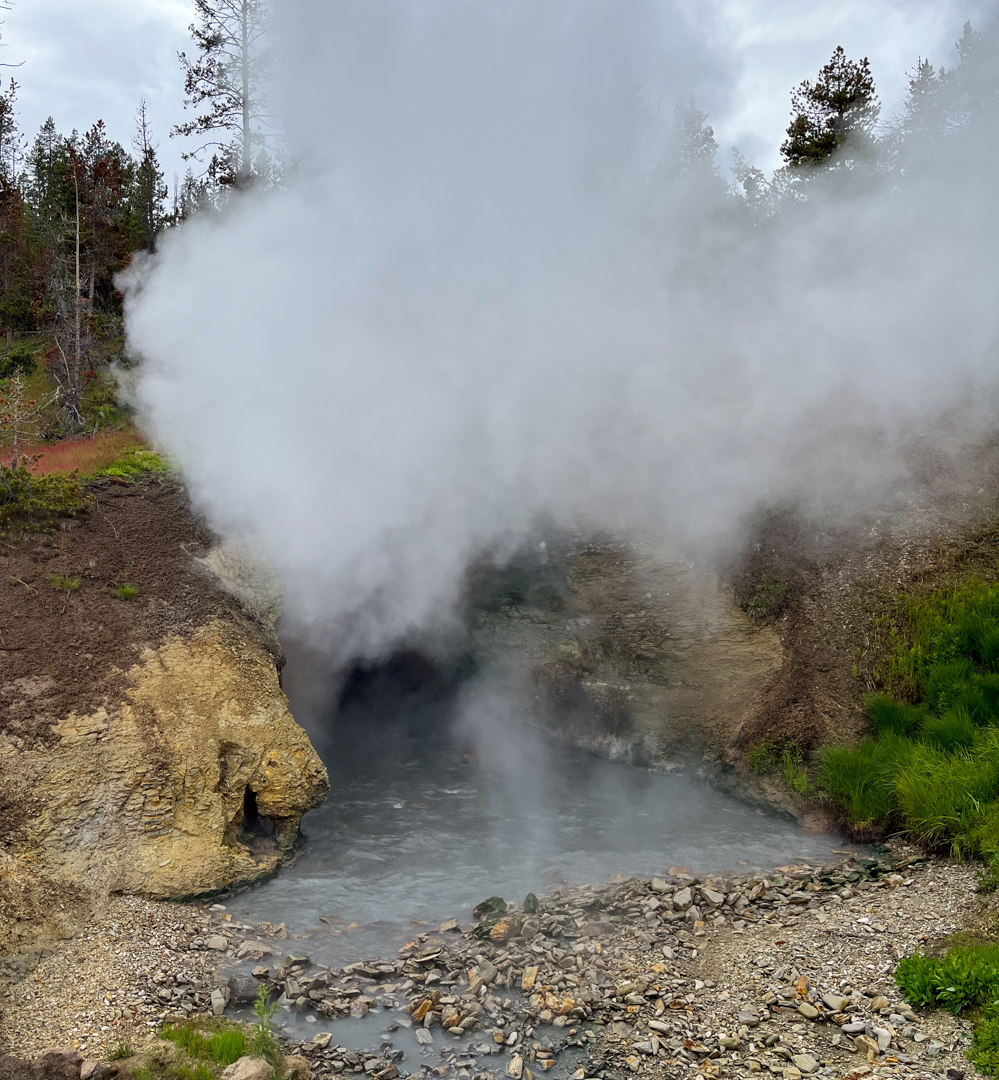
Dragon’s Mouth Spring
We were hungry and the good kind of tired after our hike and all the day’s adventures. Reflecting on the good will between the park visitors sharing information and spotting scopes, as well as their personal expertise and animal stories, we were reminded of the statement from the rangers at the Yellowstone Visitor Center that we humans are part of the Yellowstone migration story. We are so grateful to be a part of this magnificent place and its magnificent story.
A small, dedicated crew departed the lodge at 5:15 a.m. for wildlife viewing and a hike while the folks left behind took advantage of a rare opportunity to get some much-needed extra rest. On the crew’s outing, they hiked to Trout Lake and saw a bald eagle perched on a snag before it took off right over head, a bison carcass, fairy shrimp, and a muskrat. Our trip leaders enjoyed a face plunge into the frigid water before heading back to the lodge where the rain was pouring. With the town’s power out and no sign of the rain letting up, we did what all good teachers do, we pivoted. After all, one of our group goals for the trip is to “go with the flow”.
Heading to Roosevelt Lodge for brunch (that quickly evolved into lunch), we noticed a hoard of spotting scopes on a knob in the Lamar Valley, so we pulled over for a look. Wolves again. Five in total, three grays and two blacks. They were rambling through the valley before bedding down for a mid-morning nap, peacefully surrounded by bison. We resumed our journey toward lunch at Roosevelt Lodge. The lodge was constructed near the site of President Theodore Roosevelt’s camp when he visited the park in the 1800s. The log structure, with its open dining room is the ideal place for some roast beef by a hot fire in the commanding river rock fireplace surrounded by new friends and thoughtful conversation. Next stop: Canyon Village.
On the way over windy, snow-kissed Mount Washburn, we spotted seven bighorn sheep on a steep, rocky slope. Bouncing into the air, twisting and playing, the sheep put on a show for our chilly group. Bonus points for readers: what is a group of sheep called? Taking in the fire-scarred landscape on our way into the canyon, we reflected on how a destructive force like wildfire is a catalyst for new life. In 1988, the park experienced one of its largest recorded fires ever, burning 1.4 million acres in the Greater Yellowstone Ecosystem. These wildfires are important for fire-dependent species, nutrient cycling and wildlife.
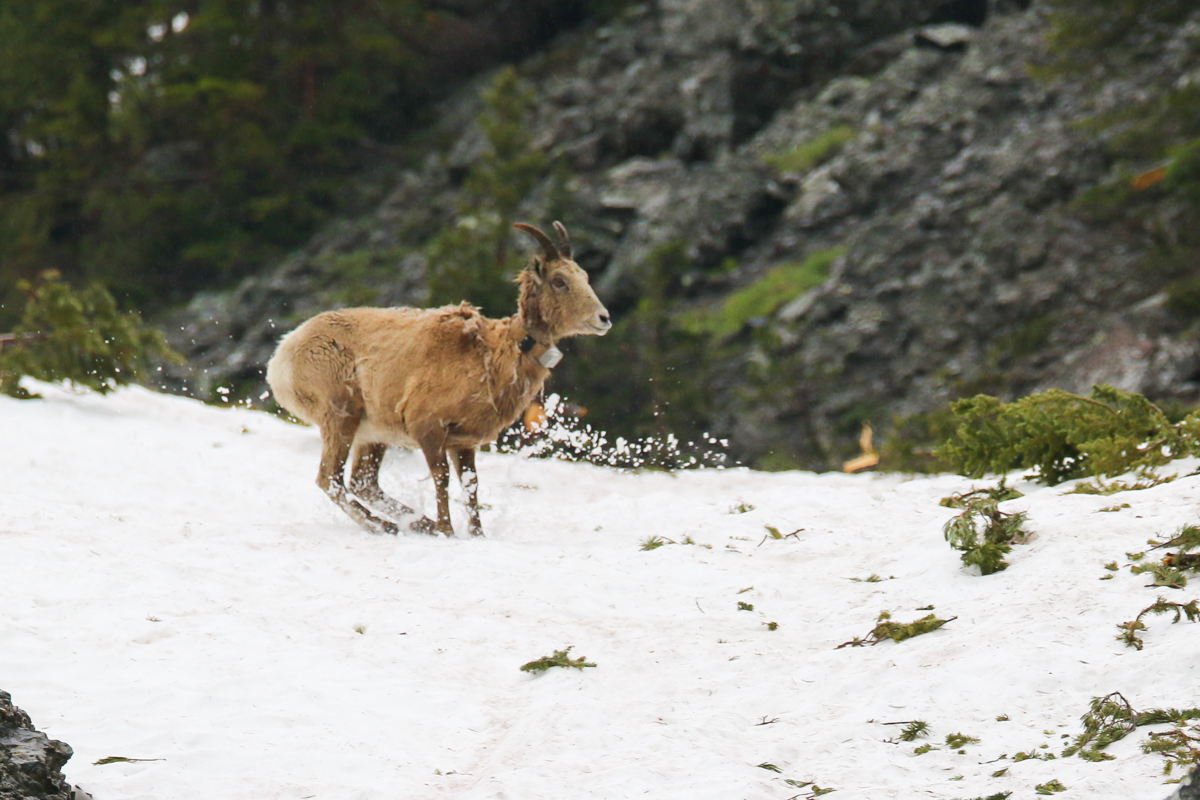
As the rain tapered off, we enjoyed some retail therapy and flushing toilets in Canyon Village. Notice: If you have requests for souvenirs, please send them to your trip participant immediately. We enjoyed a hike “right off the road” (we are quickly learning that the participants have different meanings for this phrase than our brave trip leaders) descending into the Grand Canyon of Yellowstone to the top of Lower Falls. We all tested our nerves inching towards the edge for a picture in front of the raging Yellowstone River plunging 309 feet into the canyon below. For a different perspective, we hiked up and out to Lookout Point for a zoomed out view of the falls.
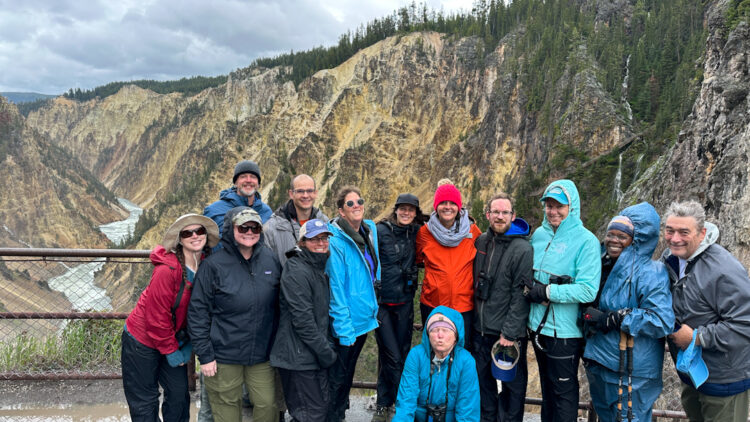
After dinner at the Canyon Village Eatery, we stopped near the rim of the Yellowstone Caldera for a quick lesson on the geology of the park. Yellowstone’s landscape has been shaped by volcanic activity, lake deposits, and glaciers for the past 570 million years and includes three major eruptions. Ash from one of eruption stretched all the way to the Midwest! These eruptions created calderas, or depressions in the Earth’s surface that result from the eruption being so violent that is blows apart the landscape. We had a team meeting at Slough Creek, passed through the Lamar Valley, navigated a bison jam, and returned to our lodge as the sun set on another day of wandering and wondering in Yellowstone.
Copyright 2018 NC Museum of Natural Sciences